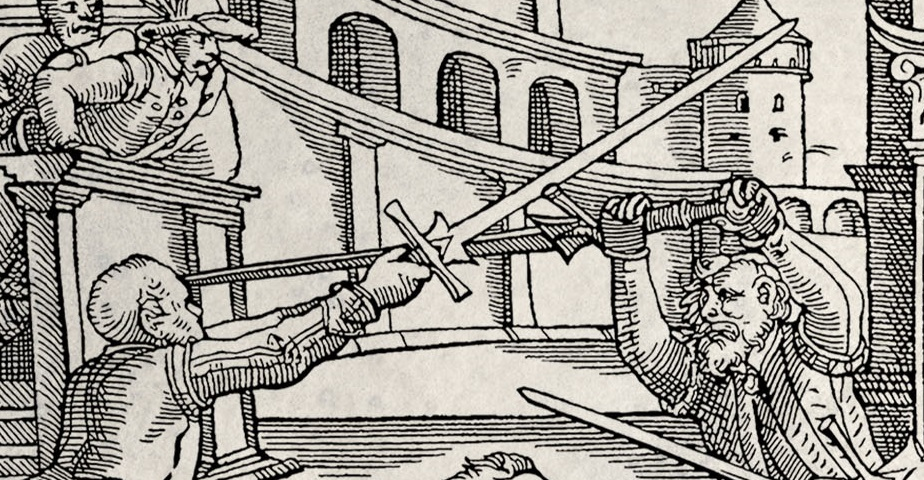Zwerch
(→Execution) |
(→Full Cut) |
||
| Line 18: | Line 18: | ||
When used to counter a zornhauw the fencer steps in, catching the zornhau on the strong on of the sword near the guard, and simultaneously striking to the opponent’s upper left opening. | When used to counter a zornhauw the fencer steps in, catching the zornhau on the strong on of the sword near the guard, and simultaneously striking to the opponent’s upper left opening. | ||
| − | |||
| − | |||
| − | |||
| − | |||
===== Abbreviated Cut ===== | ===== Abbreviated Cut ===== | ||
Revision as of 01:21, 20 December 2016
Contents |
Thwart
On of the five meisterhauw, the zwerch breaks vom tag and counters the zornhauw/oberhauw.
Execution
Full Cut
This is a sweeping version of the cut which comes around in a broad movement.
Generally speaking Meyer categorises this among the "crooked cuts", which is to say cuts which move through a crossed hands position (not to be confused with the canonical "Crooked Cut/Krumphauw").
The zwerch is a strike performed with the hands high ending almost in an ochs position. The easiest way to imagine a zwerch is to stand in ochs rechts (left leg forward), thumb under the blade. Keeping the hands up high and the thumb under bring the sword around overhead in a sweeping movement, stepping forward with the right and ending basically in left ochs.
The "zwerch line" from the text shows a horizontal cutting line; however this need not mean the cut is performed strictly horizontally. The description of the zwerch in the section concerning strike in the 1570 text seems to follow a rising line based on both the text and the attending image. Throughout the remainder of the text the zwerch seems to appear most commonly as a cut along diagonal lines, though often on a shallow angle.
When used to counter a zornhauw the fencer steps in, catching the zornhau on the strong on of the sword near the guard, and simultaneously striking to the opponent’s upper left opening.
Abbreviated Cut
It should be noted that the zwerch need not be carried out with such a broad 'helicopter' movement, and is often more effective as a very tight movement. For example, one can zwerch from a right ochs position to the opponent's upper left opening with a passing step by flicking the tip of the blade around in a tight arc without coming around behind one's head rather than bringing the blade all the way around.
Application
The basic zwerch described moves around in a broad overhead movement, but the zwerch need not go all the way around the head in a looping movement (Rinde). More often we use a tight zwerch motion. For example, from an ochs on the right side the fencer can step to the right and move the blade around in a tight loop through Einhorn and back down to cut a short zwerch to the opponent's left ear.
The zwerch can also be used diagonally instead of horizontally, and flitting over (Verfliegen) to the opposite diagonal opening is a common use for the zwerch.
Meyer also uses the zwerch as one of his generic withdrawing movements through the Stages of the Exchange, providing a threat with a cut, and danger from the point, and protecting against strikes from above.
Application Example
In which the 'student' demonstrates their knowledge to the 'teacher'.
| Teacher | Student |
|---|---|
| Zornhut, left leg forward | Zornhut, left leg forward |
| Passing Step Zornhauw | Passing Step forward and right |
| Zwerch, catching blade on crossguard, Triangle Step with rear leg to face toward the teacher. |
